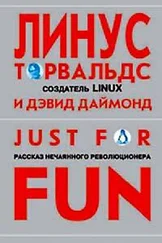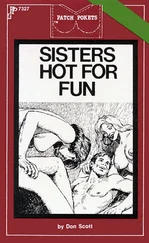"A few. I never was very social. I'm way, way more social now than I was back then. "
"Well, what was it like? I mean, do you remember waking up on a Sunday morning and going somewhere with your sister and your parents?"
"My parents were split up by then."
"How old were you when they split up?"
"l don't know. Maybe six. Maybe ten. I don't remember."
"What about Christmas? Do you remember Christmas?"
"Ob, I have some vague memories of getting dressed up and going to my paternal grandfather's house in Turku. Same thing for Easter. Other than that I don't remember much. "
"What about your first computer?"
"That was the famed VIC-20 my maternal grandfather bought. It came in a box. "
"How big was the box? The size that would hold a pair of snow boots?"
"About that size."
"And what about your grandfather? Do you remember much about him?"
"He was probably my closest relative but I don't. .. Okay. He was overweight, but not fat. He was balding. He was withdrawn, sort of like an absent-minded professor, which he was. I used to sit on his lap and type in his programs. "
"Can you remember what he smelled like?"
"No. What kind of a question is that?"
"Everybody's grandfather smells like something. Cheap cologne. Bourbon. Cigars. What did he smell like?"
"l don't know. I was too preoccupied with the computer to notice."
Birth of an OPERATING SYSTEM*
*Warning: Intermediate geek language until page 119.
Some people remember time according to the cars they drove or the jobs they held or the places they lived or the sweethearts they dated. My years are marked by computers.
I had only three computers while I was growing up. There was the aforementioned Commodore VIC-20, which I inherited from my grandfather. It was one of the first "home" computers, the predecessors to the present-day PCs. The Commodore 64 became sort of the big brother to the VIC-20, followed by the Amiga, which had a particularly strong following in Europe. Those computers never became truly popular, like the PC or even the Apple II, which was already common about the time I played around with the VIC.
In those days before the proliferation of PCs, most of the programming on home computers was done in assembly language. (I can't believe I've taken to starting sentences with "In those days...") Computers had their own home-brew operating system, the equivalent of what DOS was on a PC. Depending on the computer, it was either a rudimentary format or a slightly more enhanced one. Like DOS, the OS had a program loader and a basic language environment. Back then there were no standards and a number of companies wanted to control the market. Commodore was one of the better known of these.
When I had gotten about as much as I could out of the VIC-20, I started saving up for a next-generation model. This was a big deal in my life. As I mentioned, I've lost track of who in my family was living where at what particular time, and a lot of other things, but the path to my second computer was something that's hard to forget.
I had some Christmas-and-birthday money stashed away (because I was born on December 28th, the two occasions are sort of melded together). I also earned some money one summer working on the clean-up crew in Helsinki's parks. Many of the parks in Helsinki aren't landscaped and well-maintained, but are more like recreational or green areas that are overgrown forests. What we had to do was saw off overgrown bushes or pick up dead branches -- it was even interesting. I've always liked the outdoors. I also had a newspaper route, too, at one point-except that it wasn't newspapers, it was junk mail. Actually, I wasn't really into summer jobs, come to think of it. But I did them in those days. On the whole, I probably got more money from school stipends.
In Finland, it's relatively common for people to give endowments to schools, even the public elementary schools. So, starting in fourth grade, money gets distributed to students based on whatever the person setting up the fund had in mind. I remember one of the endowments in my school went to the best-liked kid in class. This was in sixth grade and we actually voted within the class on who should get the money. It wasn't me who won, I might add. The bounty amounted to only about 200 Finnmarks, which was maybe forty dollars, at the time, but it seemed like a lot of money to give a sixth grader just for being popular.
Quite often the money went to the best person in a particular subject or sport. And a lot of the awards were school-specific or funded through the government. In some cases, the funds dwindled over time. I remember one that amounted to about a penny in value. When that was the situation, the school would chip in to make it somewhat more useful, but it still was a fairly small sum of money; more than anything else, this was a way of maintaining the tradition of giving out money every year. Finland takes its academic traditions seriously,which is a good thing.
So I would receive these stipends every year for being the Math Guy. By high school the awards got bigger. The biggest ones were on the order of $500. So that's where most of the money for my second computer came from; my weekly allowance wouldn't have paid for a computer. I also borrowed some money from my dad.
It was 1986 or 1987. I was sixteen or seventeen. My basketball years were behind me. I spent an inordinate amount of time researching the field before deciding which computer to buy. PCs weren't very good back then, so when I fantasized about my new machine I knew it wasn't going to be a PC.
I opted for a Sinclair QL, which many of you are probably too young to remember. Here's the history. The Sinclair was one of the first 32-bit machines on the market for home use. Sir Clive Sinclair, the founder of the company, was the Steve Wosniak of Britain. He made these computer kits that were sold as Timex computers in the United States. That's right, the same company that made Timex watches imported the Sinclair computer stuff and sold it here under the Timex name. The early ones were sold as kits before he started selling ready-made computers.
The Sinclair had this operating system called Q-DOS. I knew it by heart back then. It was written especially for that particular computer. It had quite an advanced Basic for the time, and fairly good graphics. One of the things that excited me the most about the operating system was that it was multitasking: You could run multiple programs at once. However, the Basic part wasn't multitasking, so you couldn't run more than one Basic program at once. But if you wrote your own programs in assembly language, you could let the operating system schedule them and time slice it so you could run many of them at the same time.
The computer contained the 8-megahertz 68008 chip, which was the second and cheaper version of Motorola's 68000 chip. Internally, the first generation of 68000 chips were 32-bit, but externally had a 16-bit interface to anything outside the CPU (central processing unit) -- such as memory or hardware add-ons. Because it could only load 16 bits at a time from memory, 16-bit operations were often quicker than the 32-bit operations. The architecture was hugely popular and it still exists today in a lot of embedded devices or cars. It's not the same chip, but it's based on the same architecture.
The 68008 chip, the version in my computer, used 8 bits, not 16 bits, for its interface with the world outside the CPU. But even though it interacted with the outside world at 8 bits at a time, internally it was 32 bits. That made it more pleasant to program in many ways.
Читать дальше












